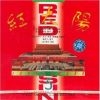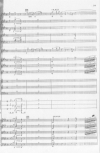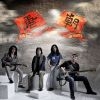
Illustration:
ill. 2.8 (set: 2.8)
Author:
Tan Dun (1957-) 谭盾
Date:
1996
Genre:
sheet music
Material:
scan, paper, black-and-white; original source: music sheet, paper
Source:
Tan Dun 1996: Tan, Dun. Orchestral Theatre III: Red Forecast. New York: G. Schirmer Inc., 1996:84.
Courtesy:
Schirmer
Keywords:
Red Forecast, Tan Dun, We shall overcome, Red is the East, Sailing the Seas Depends on the Helmsman,Red is the East, Internationale, Four Prominences, Cultural Revolution musical theory, blasphemy, Jiang Qing
Tan Dun: Red Forecast
Tan Dun’s 1996 Red Forecast: Orchestral Theater III is a multimedia work. Not unlike the model works of the Cultural Revolution that combined music, text, gestures, costumes, setting, and lighting to great (didactic) effect (Mittler 2003, Mittler 2006), Red Forecast juxtaposes music and text (including a recording of weather forecasts in five different languages), video footage, and light. Red Forecast is dominated by two major themes: the weather and the 1960s. The weather is used as a metaphor for history (and since ancient times, the weather had been read as an indicator of the will of cosmic powers in China): unpredictable and yet unchangeable. The 1960s, meanwhile, symbolize for Tan Dun an idealism that was behind much of the thinking in Mao’s Cultural Revolution. According to Tan Dun, however, Red Forecast is neither a political statement nor a reflection of nostalgic memories. Tan Dun intends his piece to be a lament for the loss of this passionate idealism, which was pervasive not just in China but throughout the entire world during this era.
The fifth movement (“Storm and Documentary” which begins at around min. 32:00 in mus. 2.9) is a surrealist collage made up of different political songs—“We Shall Overcome,” the “Internationale,” ”Red Is the East”—as well as another important song during the Cultural Revolution, “Sailing the Seas Depends on the Helmsman.” If meetings during the Cultural Revolution opened with the singing of “Red Is the East,” they ended with “Sailing the Seas Depends on the Helmsman” (mus. 2.8). Along with “Red Is the East” and the “Internationale,” then, this song was certainly one of the most frequently heard during the Cultural Revolution.
“We Shall Overcome,” on the other hand, which Tan Dun also uses in this medley movement, originated as the anthem of the Civil Rights Movement in the United States. Propelled by the world student movements of the late 1960s, it has come to stand for freedom, liberation, and political protest within the larger global context, and it has carried the hopes of many different people and many different causes. As such, it was borrowed by the Chinese students when they faced military tanks on Tian’anmen in 1989 (DACHS 2008 We Shall Overcome, Chronology). The song was not officially propagated during the Cultural Revolution, and it was not printed in the enormously popular collection of foreign songs entitled 200 Famous Foreign Songs (外国名歌二百首 Waiguo mingge erbaishou), carried around by almost every sent-down youth.
How, then, does one interpret the dizzying combination of the Maoist words “There will be thunderstorms, press east toward west by evening” and pictures of a red sun and Mao Zedong waving his hand up and down in fast motion, together with “We Shall Overcome” played very slowly and emotionally in the high strings in Tan Dun’s piece? And what do we make of the appearance, just a fraction later, of “Navigating the Seas Depends on the Helmsman” (ill. 2.8, p. 84 C, b. 43, at around min. 34:13 in mus. 2.9) and small fragments from both “Red Is the East” (ill. 2.8, p. 84C, b. 44/45) and the “Internationale” (Ibid., b. 46–50) in the woodwinds, again accompanied in counterpoint by “We Shall Overcome” in the strings (Ibid., b. 45)? To equate Mao’s revolution to a thunderstorm pressing towards the West may be acceptable (indeed, it is his own words that the “East wind prevails over the West wind” [东风压倒西风] (Mao 1957a). But to show in fast motion the image of the Great Chairman repeating the same characteristic movement again and again like a puppet, and all this to the sounds of “We Shall Overcome,” (e.g. at around 39.09 in mus. 2.9), a political song of American origin, that appears as a dominant counterpoint in the strings while the hymn to the Helmsman is delegated to the unimportant woodwinds and “Red Is the East” and the “Internationale” are fragmented into oblivion (as seen in the score)—this may be considered blasphemy!



































